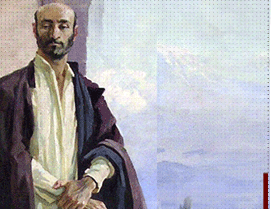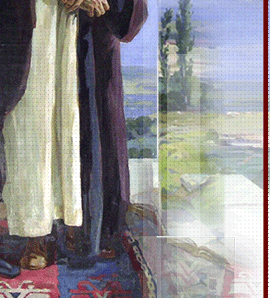| WRITERS ABOUT KOMITAS
In all of the Armenian
history there is no other cultural figure that would be the image
to which almost all the poets of the 20th century turned.
Poets of all styles and directions wrote about Komitas throughout
the century. There are both small couplets and long poems –
legends about his life and music.
The first significant work about Komitas in the 20th century Armenian
literature is Eghishe Charents’s ode-poem to Komitas.
In 1936 Vardapet’s ashes were transported to Yerevan and he
was buried in the pantheon. Charents finished this sensitive, bright
and impressive literary work under the fresh impressions of those
days. The highest stanzas are devoted to the perpetual return of
Vardapet.
Around the same period another great Armenian poet Paruyr Sevak,
while a student, makes his first attempts to turn to the legendary
figure of Komitas. In 1949 Sevak wrote the poem “Two more
decades”, dedicated to the 80th anniversary of Vardapet. In
1956 he creates a verse, which later on becomes the epigraph to
the renowned “The Ever-ringing Belfry”. In 1959, 10
years after his first attempt, Paruyr Sevak created this masterpiece,
which is still considered the best story about Komitas.
The translation of the “The Ever-ringing Belfry” was
made by Harold Registan in 1982. According to the translator, the
poem’s architecture is very complex. It is divided into 6
large parts, which in their turn are subdivided into chapters with
peculiar rhythm and highlighted separate lines.
No doubt the most vivid part is the beginning.
Komitas’s academic years in Berlin are poetically depicted
in the “Toll of the sunset”.
“The Toll of the Genocide” is the strongest and largest
part in Sevak’s poem. It is the embodiment of the national
theme of the dreadful genocide.
“The Toll of Obscurity” narrates about Komitas’s
illness after the exile.
And the last part is the optimistic finale of the tragedy called
“Pacifying Echo”. Here the image of Komitas is personified
in the contemplations of the author. Here he is resurrected and
returned to his people, to his land… The toll of pacification
puts an end to this monumental literary work.
In 1969 “Hayastan” (“Armenia”) publishing
house release a collection of poems devoted to Komitas – “Garun
a” (“It is spring”). It was a collection of 45
poets.
Along with the works written after Vardapet’s death, the collection
also contained poems of his contemporaries – those of them
who actually saw him and talked to him; for example, Azat Vshtuni’s
poem “To Komitas” written in 1917, or “Komitas
Vardapet” of the western Armenian poet Vahan Tekeyan written
in the form of an ode. Two poems of Gurgen Maari are also published
here: “A song to Komitas” (1927) and “Komitas”
(1932). The first one is in the form of a lullaby for Komitas’s
songs, and the second one is the expression of the author’s
feelings in the form of a prayer to the ill, fading genius.
Sarmen’s two poems are written in the form of a short epic
narration.
The first one was written in 1932 and dedicated to the bright lyric
of Komitas. The second one – “At Komitas’s grave”
(1963) is an epitaph covered with light sorrow and faith.
The song lyrics “In memory of Komitas” of Sheram, written
right after Vardapet’s death – on October 26, 1935 –
deserves a special historic attention.
The following works belong to a bit later period: Amo Sagian, Silva
Kaputikian, Vahagn Davtian, Mari Atamachian (Armachian), Ashot Grashi,
Martiros Vesper, Aram Kotikian, Agavni, Mikael Arutyunian, Artashes
Poghosian, Vahagn Karents, Atanes Senal, Garik Bandurian, Ludwig
Durian, Vahagn Dakesian, Zhirayr Avetian, Vachagan Oganesian, Alec
Khachunts, and many others…
One of the largest latest works devoted to Komitas is Levon Miridjanian’s
poem “The shepherd of the song”.
Like Sevak, consistently revealing the historical events of Vardapet’s
life, Miridjanian divided his narration into chapters with symbolic
names. Each verse is dedicated to various life aspects of the musician,
and each of them starts with the same words: “the flock was
drawing to the mountains…”. The emotional coloring of
the verses changes depending on the contextual stanza.
|


